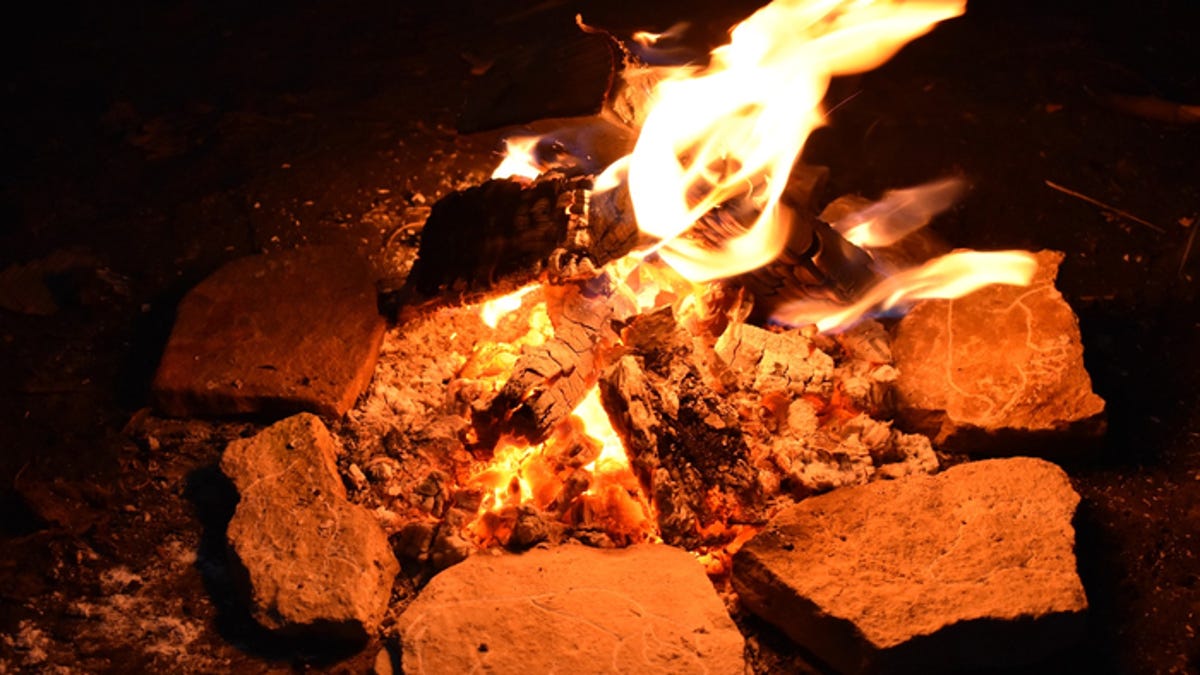Prehistoric Painters Might've Used Fire to Create Psychologically Stimulating Art
15,000 years ago, art mixed with flames led to incredibly immersive cave galleries.

Photograph showing ambient light levels and the position of replica plaquettes in relation to the fire during the researchers' experiments.
In a toasty cave 15,000 years ago, the Magdalenian people of early France sat huddled around a campfire. They carved slate-colored stones beside the flickering flames, drawing intricate patterns and bold figures. Centuries later, archeologists excavated and set these artistic pieces on display in the British Museum -- but behind glass walls, the plaques held a mystery.
Some are stained, with pinkish edges singed by the fire that once illuminated them.
Many researchers assumed the rosy chars were products of accident. Perhaps eager artists sat too close to the fire while detailing their rocky creations. However, as described by research published Wednesday in the journal PLoS One, scientists who used virtual reality software to re-create and zoom in on 50 of these scorched plaques came up with a new, much more artistically minded theory.
The Magdalenian people might've risked burning their creations because the flames were part of their artwork -- they saw fire as an artistic tool to make incredibly visceral creations.
"Experiments with replica plaquettes showed the damage was more consistent with being purposefully positioned close to a fire," Andy Needham, an archaeologist at the University of York and lead author of the study, said in a statement.
"In the modern day," Needham continued, "we might think of art as being created on a blank canvas in daylight or with a fixed light source; but we now know that people 15,000 years ago were creating art around a fire at night, with flickering shapes and shadows."
You can see the pinkish edges on the left sides and bottom right edge of this engraved stone.
It's like the ancient community employed a mixed media technique for their creations, except instead of calling on pen, pastels and maybe oil paint like contemporary artists -- whose work you might find in a progressive museum -- they used flames, earth and engravings.
Fresh white lines made with stone tools against the fire would've cast images on cave walls and each plaque's positioning would've fostered an extremely dramatic, immersive environment for the artists to work. "Creating art by firelight would have been a very visceral experience, activating different parts of the human brain," Needham said.
With such a trance-like studio, the researchers suggest the Magdalenian people were truly trying to tap into a human psychological trait called "pareidolia."
It's an evolutionary adaptation meant to protect us from predators, but the way we experience it is by unconsciously imposing meaning to patterns when there isn't any. That could include things like filling in the gaps of broken designs without realizing it, searching for figures in an inkblot test or feeling like you're seeing a bear while camping in the woods because of firelight altering the way trees look.
"We know that flickering shadows and light enhance our evolutionary capacity to see forms and faces in inanimate objects," Needham said. "This might help explain why it's common to see plaquette designs that have used or integrated natural features in the rock to draw animals or artistic forms."
Art, music and other types of culture all remind us of our humanity. We have five senses for experiencing the world, and we therefore crave things that stimulate one, two or maybe all of them at once.
And, as evidenced by the researchers' new study on Magdalenian artwork, this human desire transcends generations."Our findings reinforce the theory that the warm glow of the fire would have made it the hub of the community for social gatherings, telling stories and making art," Izzy Wisher, an archeologist at the University of Durham and co-author of the study, said in a statement.
Added Wisher, "At a time when huge amounts of time and effort would have gone into finding food, water and shelter, it's fascinating to think that people still found the time and capacity to create art. It shows how these activities have formed part of what makes us human for thousands of years and demonstrates the cognitive complexity of prehistoric people."

